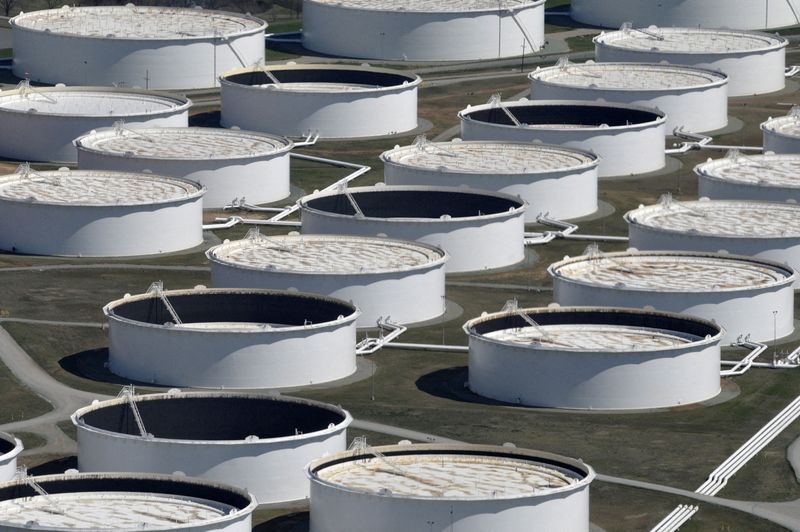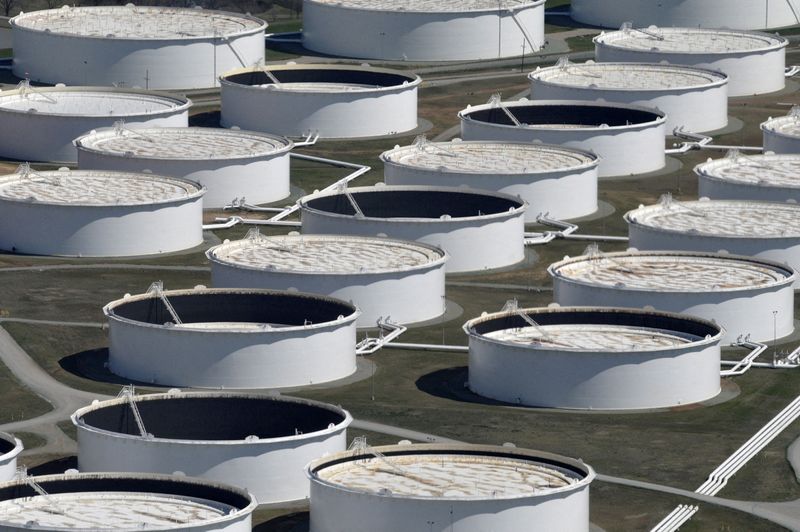Commodities
Oil tracks global equities higher, IEA demand downgrade weighs


© Reuters. FILE PHOTO: Crude oil storage tanks are seen from above at the Cushing oil hub, appearing to run out of space to contain a historic supply glut that has hammered prices, in Cushing, Oklahoma, March 24, 2016. REUTERS/Nick Oxford//File Photo
By Ahmad Ghaddar
LONDON (Reuters) -Oil prices rose about 1% on Thursday, reversing earlier falls, on expectations that U.S. interest rates had peaked, but a lower demand growth forecast for next year from the International Energy Agency and higher U.S. inventories limited further gains.
futures rose $1.01, or 1.20%, to $86.83 a barrel at 0952 GMT, while U.S. West Texas Intermediate crude gained 73 cents, or 0.90%, to $84.22 a barrel.
World shares rose and the dollar and bond market borrowing costs held steady ahead of U.S. inflation data and European Central Bank meeting minutes that will add to the hotly-contested debate on where interest rates are heading.
Lower U.S. bond yields are stoking risk appetite, which in turn is supporting equities and oil, UBS analyst Giovanni Staunovo said.
“Both the Saudi energy minister Prince Abdulaziz and Russia’s deputy prime minister Novak reiterating their ongoing collaboration to balance oil markets are helping,” he added.
Saudi Energy Minister Prince Abdulaziz bin Salman said in a Russian TV interview that it was necessary to be “proactive” on bringing stability to the oil market, which had recently been hit by concerns that the Israel-Hamas war could disrupt supplies from the Middle East.
Russian Deputy Prime Minister Alexander Novak also reassured markets, saying the current oil price factored in the Middle East conflict and showed that the risk from it was not high.
Meanwhile, the IEA lowered its oil demand growth forecast for 2024, suggesting harsher global economic conditions and progress on energy efficiency will weigh on consumption.
The agency now sees 2024 demand growth at 880,000 barrels per day (bpd), compared with its previous forecast of 1 million bpd.
However, it raised its 2023 demand forecast to 2.3 million bpd from a forecast of 2.2 million.
U.S. data which showed a big build in crude and gasoline inventories tempered the rally.
oil stockpiles swelled by about 12.9 million barrels, according to market sources citing American Petroleum Institute figures on Wednesday. [API/S]
This was much higher than the 500,000-barrel gain expected by analysts in a Reuters poll.
Gasoline inventories also rose by 3.6 million barrels, the data showed, a stark contrast from the 800,000-barrel drop expected by analysts and continued to stoke worries of slowing fuel demand in the U.S.
Markets will be awaiting further inventory data cues from the U.S. Energy Information Administration (EIA) due later in the day at 1500 GMT.
Commodities
Oil prices rise; U.S. crude inventories plunge, Russia-Ukraine truce eyed
Commodities
India’s Reliance to stop buying Venezuelan oil over US tariffs, sources say
Commodities
Oil prices climb on Venezuela supply worries

 Forex3 years ago
Forex3 years agoForex Today: the dollar is gaining strength amid gloomy sentiment at the start of the Fed’s week

 Forex3 years ago
Forex3 years agoUnbiased review of Pocket Option broker

 Forex3 years ago
Forex3 years agoDollar to pound sterling exchange rate today: Pound plummeted to its lowest since 1985

 Forex3 years ago
Forex3 years agoHow is the Australian dollar doing today?

 Cryptocurrency3 years ago
Cryptocurrency3 years agoWhat happened in the crypto market – current events today

 World3 years ago
World3 years agoWhy are modern video games an art form?

 Commodities3 years ago
Commodities3 years agoCopper continues to fall in price on expectations of lower demand in China

 Economy3 years ago
Economy3 years agoCrude oil tankers double in price due to EU anti-Russian sanctions























